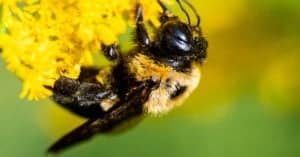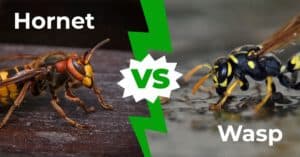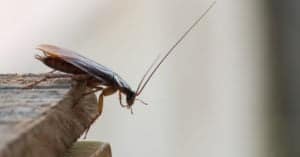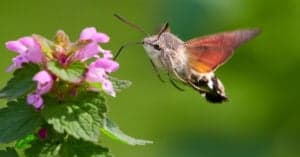Are Cicadas Dangerous?
@media (min-width: 481px) {
.mobile-top-content {
display: none;
}
}
#mobileTopContentCTACarouselControls { overflow: hidden; text-overflow: ellipsis; white-space: nowrap; }
.mobile-top-content .more { color: #fff; }
.mobile-top-content a { color: #fff; text-decoration: underline; }
.mobile-top-content a:hover { color: #fff; text-decoration: underline; }
@media (max-width: 480px) {
.mobile-top-content {
background-color: #06a10b;
color: #fff;
text-align: center;
/*height: 60px;
padding-top:5px;*/
font-size:80%;
/* display: block; */
margin: 0px -30px;
}
}
Over 3,000 species of Cicadas have been identified. These insects have different names depending on where you live or where you grew up in the United States. During the summer, you may have heard cicadas referred to as Jarflys, Harvest Fly, or even “Dog Day” cicadas. The 13 and 17-year periodic Cicadas that are common in Eastern Northern America belong to the Magicicada genus. To some, cicadas are fascinating, but to others they can be a loud nuisance. They can actually reach 90 decibels, which is comparable to a lawnmower or a jet airliner landing! But are cicadas dangerous? Not really. Keep reading to understand more about how cicadas interact with people and if you should be wary of them.
Are Cicadas Dangerous?

Cicadas are not all deadly to people, despite their loud and aggressive behavior. They are not going to hurt you, even if they become disoriented or appear to be flying at you. There’s a lot of misunderstanding and misinformation concerning this strange, yet beautiful insect. One of the numerous characteristics of this intriguing insect is that it is quite harmless.
Are Cicadas Dangerous To Eat?
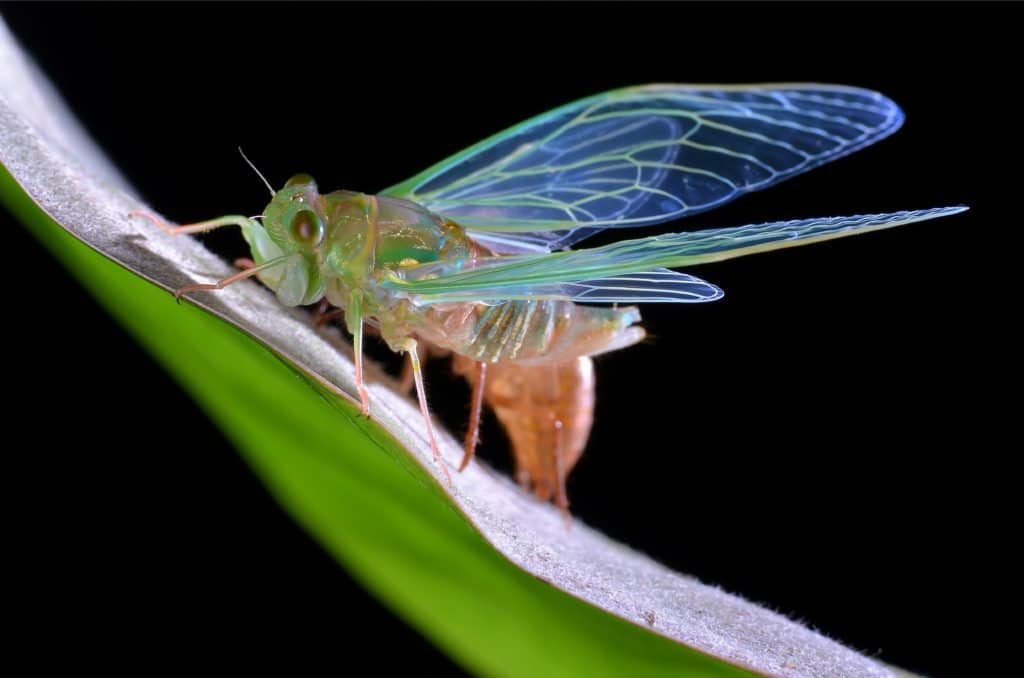
SIMON SHIM/Shutterstock.com
People can consume cicadas safely if they’re into that. They are similar to crickets, which are eaten all across the world. Cicadas may appear frightening or dangerous, but they’re quite harmless.
In fact, they can be a new addition to your diet. Yes, all you adventurous eaters, take note. Many people are repulsed by the idea of eating bugs but in some cultures, insects are a healthy protein substitute in many cases. Cicadas currently lack formal evidence on their nutritional value. However, according to the FDA cicadas should not be consumed by people with seafood allergies.
What Do Cicadas Eat?
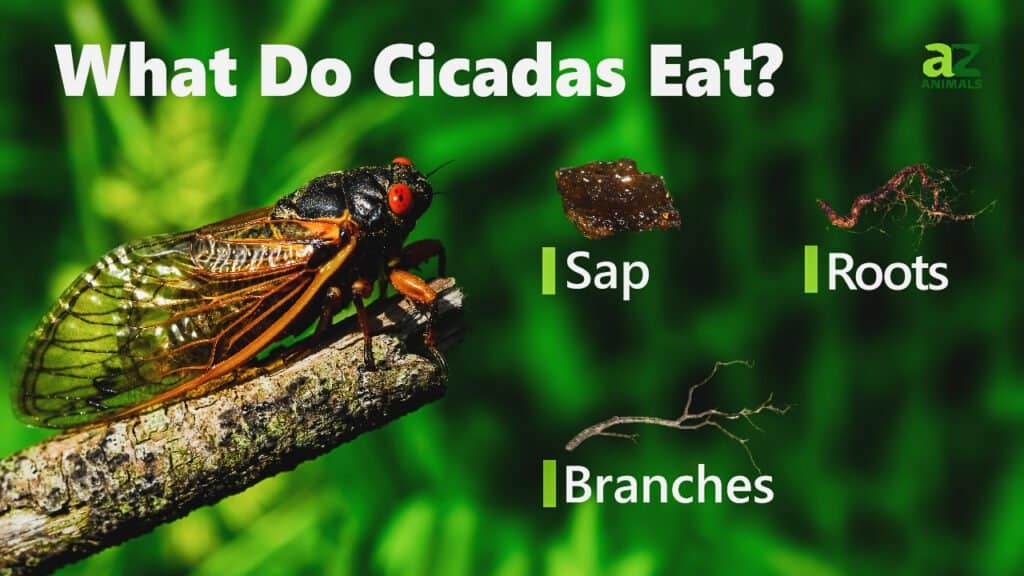
A-Z-Animals.com
Cicadas have keen sucking jaws like mosquitos and feed on underground roots, tree sap, and young twigs. Unlike locusts, they do not eat the leaves of plants. The fact that both nymphs and adults have a beak for sucking plant fluids distinguishes them from other insects.
Are Cicadas Poisonous To Pets If Eaten?

tienduc1103/Shutterstock.com
Cicadas aren’t dangerous in and of themselves. But they might cause pain or gastrointestinal problems if they’re not part of your pet’s regular diet. Millions of cicadas are bursting across areas of the eastern United States and Midwest and dogs and cats love to devour these winged insects.
How Often Do Cicadas Come Out?
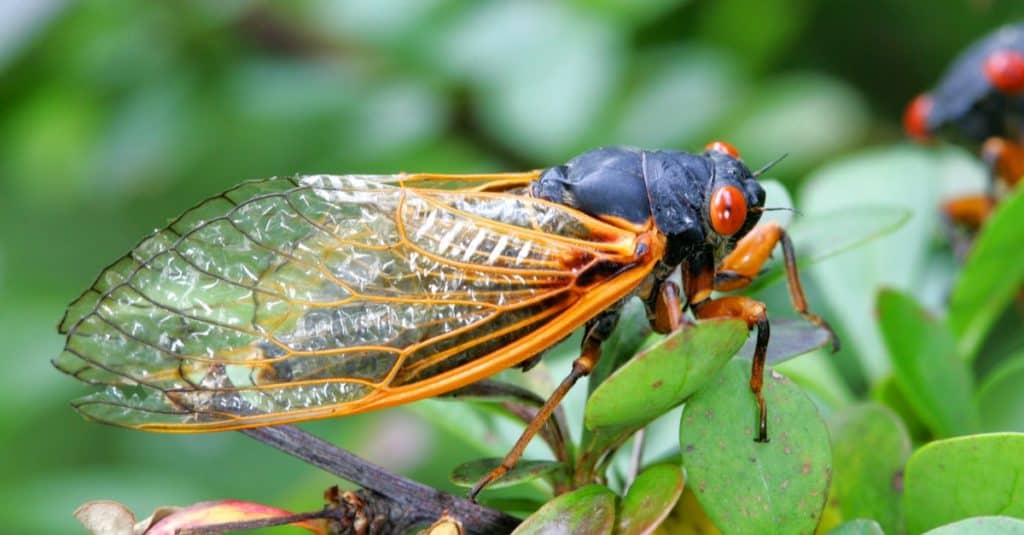
Chris Alcock/Shutterstock.com
Many cicada species emerge every year. Cicada populations in the United States have been known to live underground for 13 to 17 years. They’re referred to as “periodic broods.” The life cycle of the 13-year cicada differs from that of the 17-year cicada. When they’re ready, they’ll emerge at the same time. Cicadas appear every 17 to 18 years on average. Only a few weeks will the cicadas be above ground, allowing them to mate and breed. Despite their brief visit, they will have a long-term impact on wildlife populations.
Where Do Cicadas Live?
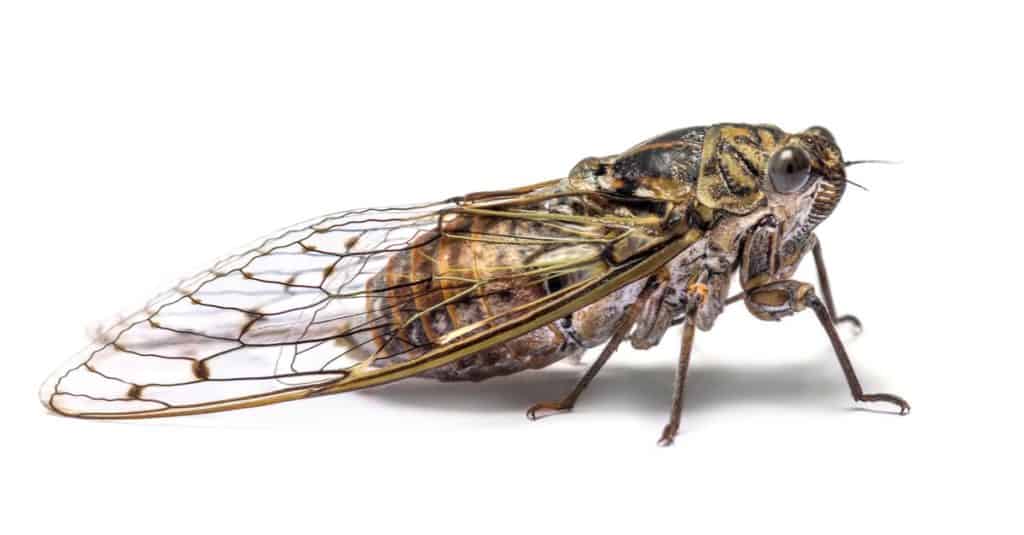
Eric Isselee/Shutterstock.com
Cicadas spend their adult lives among the tops, trunks, and short twigs of trees and plants. Cicada adults mate by cutting small openings in the delicate twigs and small branches of their host plants, where the females lay their eggs.
How Long Do Cicadas Live?
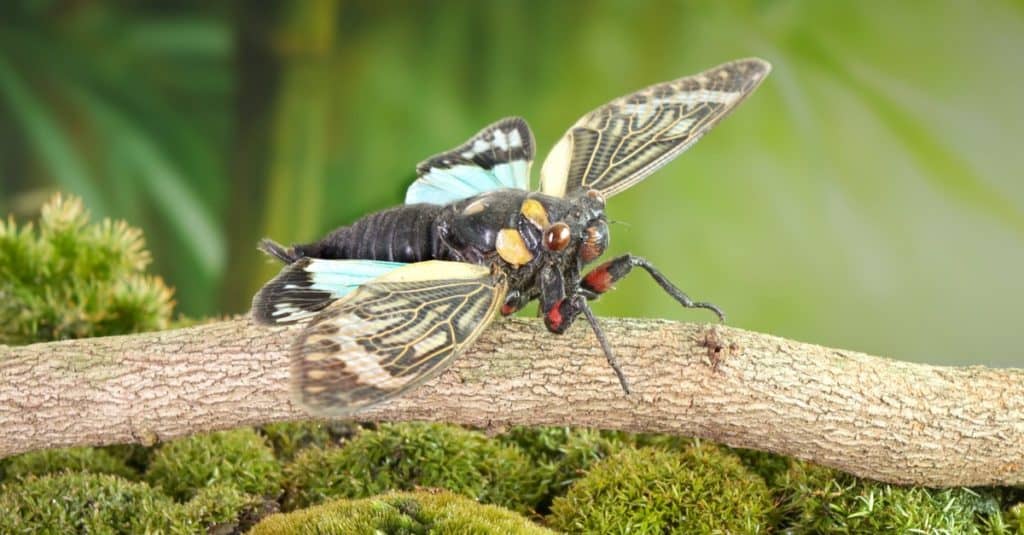
Mark Brandon/Shutterstock.com
The periodic cicadas can survive in their nymphal, below-ground nest for 13 to 17 years if left alone! Cicada colonies can be found in a range of years and locations. Brood X, as in the Roman numeral 10, is the name of this year’s group. There are fifteen broods that develop on a consistent basis. Others have vanished entirely from the face of the world.
Are Cicadas Known To Move In Swarms?
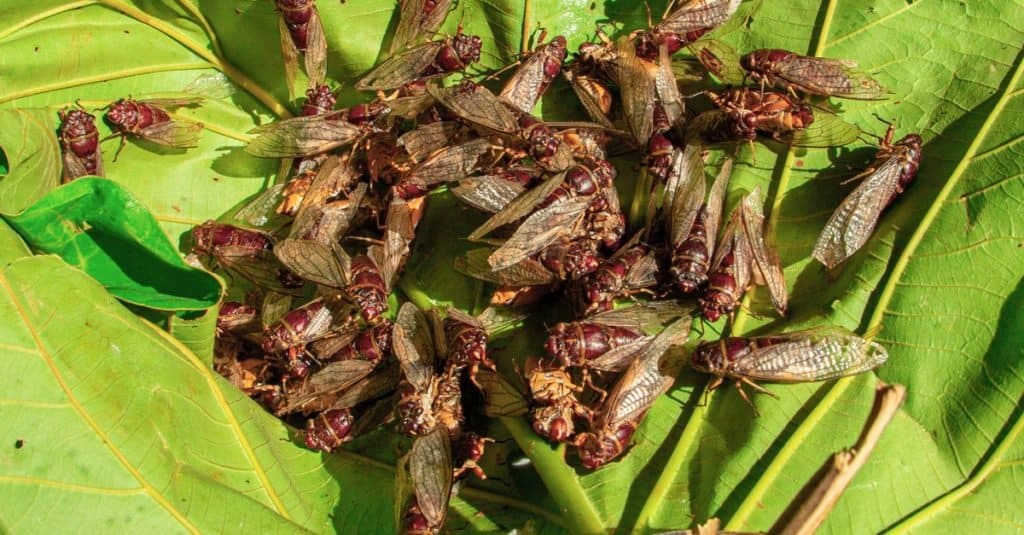
Cicadas, unlike other migratory insects, are not known for flying vast distances and prefer to stay close to the ground. Cicadas also don’t usually travel in huge groups, even though they emerge from the ground in large numbers. They don’t swarm in the same way as bees and locusts do, so they are not dangerous in the sense that they would swarm at you. In the United States, broods of cicadas have been given letter names according to their life cycle and which years they will hatch, such as Brood X, hatching in 2021.
Why Do Cicadas Sometimes Fly At You?

Jonathan Steinbeck/Shutterstock.com
It’s not on purpose if a cicada lands on you. Cicadas typically fly around in search of trees or shrubs that are densely wooded. When flying in urban areas, cicadas may have to fly around for quite some time to find the perfect position for their eggs. Humans may get crashed into during the search.
Do Cicadas Bite Or Sting?
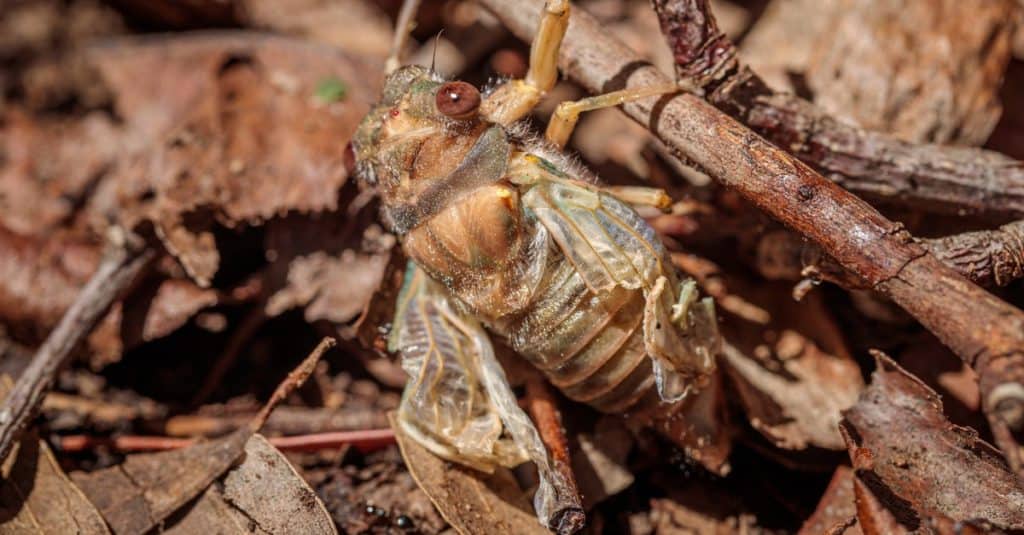
Instead of biting or stinging, cicadas pierce the skin. They lack jaws or mandibles that are designed to tear and swallow flesh, unlike wasps, mantises, and ants. Cicadas lack stingers, which are used by bees and wasps to inject poison into their victims, immobilizing or harming them.
Unless they have been permitted to linger on someone for an extended amount of time, adult cicadas will not attack. It takes a long time for a cicada to mistake a human body part for a plant.
Can Cicadas Lay Eggs Inside Your Skin?

suradech123yim/Shutterstock.com
No, cicadas can’t deposit eggs in your skin, according to entomologists. Female cicadas make openings in little tree branches and lay eggs in each one. After that, the cicadas fall to the ground and burrow into it.
FAQs (Frequently Asked Questions)
What’s The Difference Between A Cicada And Locust?
A Cicada is a type of short-horned grasshopper that is more intricately linked to an aphid than a Locust. Locusts are longer and thinner than Cicadas, yet they share grasshoppers’ long back legs. Cicadas’ legs are exceedingly short.
More from A-Z Animals
.more-snake-card-image { max-height:140px !important; }
@media (min-width: 481px) {
.mobile-top-content {
display: none;
}
}
#mobileTopContentCTACarouselControls { overflow: hidden; text-overflow: ellipsis; white-space: nowrap; }
.mobile-top-content .more { color: #fff; }
.mobile-top-content a { color: #fff; text-decoration: underline; }
.mobile-top-content a:hover { color: #fff; text-decoration: underline; }
@media (max-width: 480px) {
.mobile-top-content {
background-color: #06a10b;
color: #fff;
text-align: center;
/*height: 60px;
padding-top:5px;*/
font-size:80%;
/* display: block; */
margin: 0px -30px;
}
}
Over 3,000 species of Cicadas have been identified. These insects have different names depending on where you live or where you grew up in the United States. During the summer, you may have heard cicadas referred to as Jarflys, Harvest Fly, or even “Dog Day” cicadas. The 13 and 17-year periodic Cicadas that are common in Eastern Northern America belong to the Magicicada genus. To some, cicadas are fascinating, but to others they can be a loud nuisance. They can actually reach 90 decibels, which is comparable to a lawnmower or a jet airliner landing! But are cicadas dangerous? Not really. Keep reading to understand more about how cicadas interact with people and if you should be wary of them.
Are Cicadas Dangerous?

Cicadas are not all deadly to people, despite their loud and aggressive behavior. They are not going to hurt you, even if they become disoriented or appear to be flying at you. There’s a lot of misunderstanding and misinformation concerning this strange, yet beautiful insect. One of the numerous characteristics of this intriguing insect is that it is quite harmless.
Are Cicadas Dangerous To Eat?

SIMON SHIM/Shutterstock.com
People can consume cicadas safely if they’re into that. They are similar to crickets, which are eaten all across the world. Cicadas may appear frightening or dangerous, but they’re quite harmless.
In fact, they can be a new addition to your diet. Yes, all you adventurous eaters, take note. Many people are repulsed by the idea of eating bugs but in some cultures, insects are a healthy protein substitute in many cases. Cicadas currently lack formal evidence on their nutritional value. However, according to the FDA cicadas should not be consumed by people with seafood allergies.
What Do Cicadas Eat?

A-Z-Animals.com
Cicadas have keen sucking jaws like mosquitos and feed on underground roots, tree sap, and young twigs. Unlike locusts, they do not eat the leaves of plants. The fact that both nymphs and adults have a beak for sucking plant fluids distinguishes them from other insects.
Are Cicadas Poisonous To Pets If Eaten?

tienduc1103/Shutterstock.com
Cicadas aren’t dangerous in and of themselves. But they might cause pain or gastrointestinal problems if they’re not part of your pet’s regular diet. Millions of cicadas are bursting across areas of the eastern United States and Midwest and dogs and cats love to devour these winged insects.
How Often Do Cicadas Come Out?

Chris Alcock/Shutterstock.com
Many cicada species emerge every year. Cicada populations in the United States have been known to live underground for 13 to 17 years. They’re referred to as “periodic broods.” The life cycle of the 13-year cicada differs from that of the 17-year cicada. When they’re ready, they’ll emerge at the same time. Cicadas appear every 17 to 18 years on average. Only a few weeks will the cicadas be above ground, allowing them to mate and breed. Despite their brief visit, they will have a long-term impact on wildlife populations.
Where Do Cicadas Live?

Eric Isselee/Shutterstock.com
Cicadas spend their adult lives among the tops, trunks, and short twigs of trees and plants. Cicada adults mate by cutting small openings in the delicate twigs and small branches of their host plants, where the females lay their eggs.
How Long Do Cicadas Live?

Mark Brandon/Shutterstock.com
The periodic cicadas can survive in their nymphal, below-ground nest for 13 to 17 years if left alone! Cicada colonies can be found in a range of years and locations. Brood X, as in the Roman numeral 10, is the name of this year’s group. There are fifteen broods that develop on a consistent basis. Others have vanished entirely from the face of the world.
Are Cicadas Known To Move In Swarms?

Cicadas, unlike other migratory insects, are not known for flying vast distances and prefer to stay close to the ground. Cicadas also don’t usually travel in huge groups, even though they emerge from the ground in large numbers. They don’t swarm in the same way as bees and locusts do, so they are not dangerous in the sense that they would swarm at you. In the United States, broods of cicadas have been given letter names according to their life cycle and which years they will hatch, such as Brood X, hatching in 2021.
Why Do Cicadas Sometimes Fly At You?

Jonathan Steinbeck/Shutterstock.com
It’s not on purpose if a cicada lands on you. Cicadas typically fly around in search of trees or shrubs that are densely wooded. When flying in urban areas, cicadas may have to fly around for quite some time to find the perfect position for their eggs. Humans may get crashed into during the search.
Do Cicadas Bite Or Sting?

Instead of biting or stinging, cicadas pierce the skin. They lack jaws or mandibles that are designed to tear and swallow flesh, unlike wasps, mantises, and ants. Cicadas lack stingers, which are used by bees and wasps to inject poison into their victims, immobilizing or harming them.
Unless they have been permitted to linger on someone for an extended amount of time, adult cicadas will not attack. It takes a long time for a cicada to mistake a human body part for a plant.
Can Cicadas Lay Eggs Inside Your Skin?

suradech123yim/Shutterstock.com
No, cicadas can’t deposit eggs in your skin, according to entomologists. Female cicadas make openings in little tree branches and lay eggs in each one. After that, the cicadas fall to the ground and burrow into it.

